《国际市场营销英语》PPT课件
- 格式:ppt
- 大小:621.50 KB
- 文档页数:12
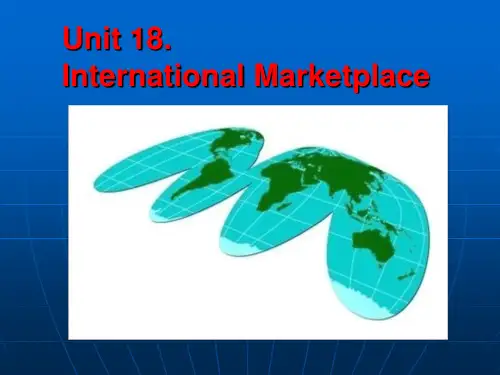

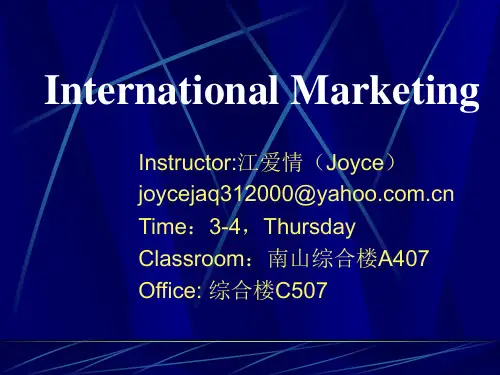
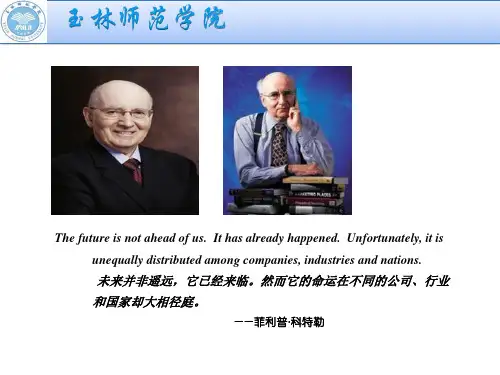
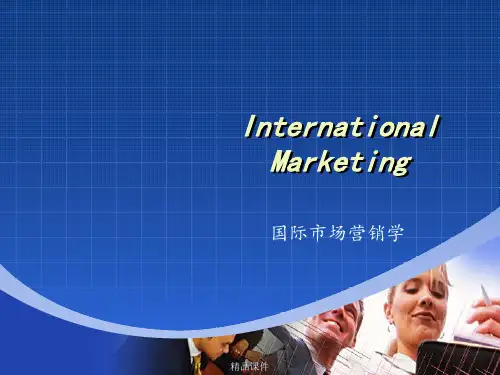
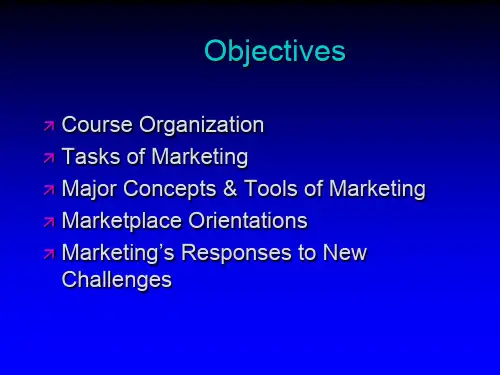
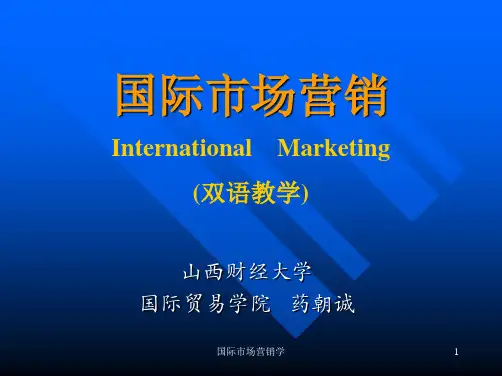
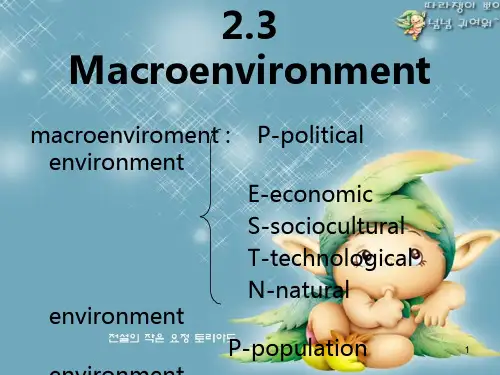
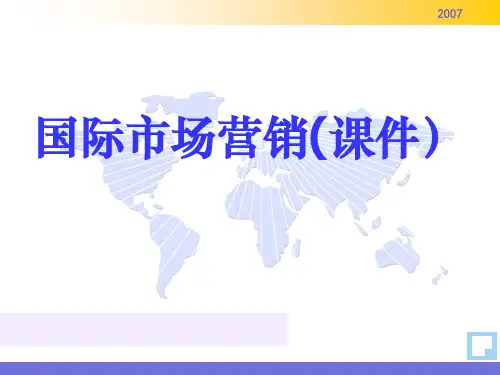
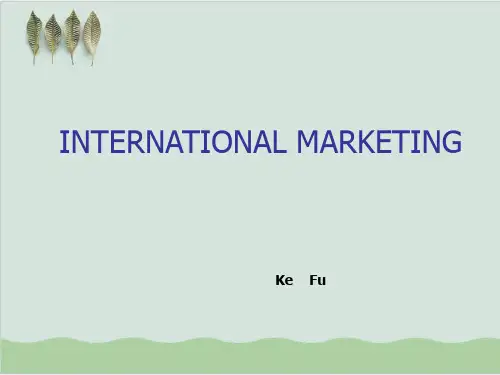

国际市场营销学培训讲义(英文版) International Marketing Training HandbookSession 1: Introduction to International Marketing1.1 Definition of International Marketing- Explanation of international marketing and its importance in today's globalized world.- Overview of key concepts, such as globalization, market segmentation, and cultural diversity.1.2 Benefits and Challenges of International Marketing- Discussion on the advantages of expanding into international markets, such as increased sales and new business opportunities. - Identification of common challenges, such as cultural differences, legal and regulatory complexities, and competitive pressures.1.3 International Marketing Strategies- Introduction to different strategies for entering international markets, including exporting, licensing, joint ventures, and direct investment.- Examination of factors influencing strategy selection, such as market potential, risk assessment, and resource allocation. Session 2: Market Research and Analysis2.1 Understanding Global Consumers- Analysis of cultural differences and their impact on consumer behavior.- Identification of global consumer segments and trends to targeteffectively.2.2 Market Research Methods- Overview of primary and secondary research methods for gathering market intelligence.- Explanation of techniques for analyzing market data, such as surveys, focus groups, and data mining.2.3 Assessing Market Potential- Examination of key factors to consider when evaluating market potential, including market size, growth rate, and competition.- Introduction to tools and frameworks for assessing market attractiveness and competitiveness.Session 3: Market Entry Strategies3.1 Exporting and Importing- Discussion on the advantages and disadvantages of exporting and importing.- Explanation of export and import processes, including logistics, documentation, and international trade regulations.3.2 Licensing and Franchising- Overview of licensing and franchising as market entry strategies. - Examination of the benefits, risks, and considerations involved in entering into licensing and franchising agreements.3.3 Joint Ventures and Strategic Alliances- Introduction to joint ventures and strategic alliances as collaborative market entry strategies.- Analysis of the advantages, challenges, and factors for successful partnerships.Session 4: Product and Brand Management4.1 Adaptation vs. Standardization- Examination of product and brand adaptation strategies to suit local market preferences.- Discussion on the benefits and risks of standardizing products and brands across international markets.4.2 Product Development and Innovation- Overview of product development processes for international markets.- Introduction to strategies for fostering innovation and staying competitive in global markets.4.3 Branding and Positioning- Explanation of brand building and positioning strategies for global brands.- Examination of the role of culture, communication, and customer perception in successful international branding.Session 5: Communication and Promotion5.1 Integrated Marketing Communications- Introduction to integrated marketing communications (IMC) and its role in international marketing.- Explanation of different promotional tools and channels, such as advertising, public relations, and digital marketing.5.2 Cultural Sensitivity in Communication- Discussion on the importance of cultural sensitivity and adaptation in international communication.- Analysis of successful cross-cultural marketing campaigns and the lessons learned.5.3 Digital Marketing in International Markets- Overview of digital marketing strategies and tactics for reaching global audiences.- Examination of the challenges and opportunities in leveraging digital platforms for international marketing.Note: This training handbook provides an overview of key topicsin international marketing and can be customized to suit specific training objectives and participant needs.Session 6: Pricing and Distribution6.1 Pricing Strategies in International Markets- Explanation of factors affecting pricing decisions in international markets, such as currency fluctuations, local market conditions, and competition.- Introduction to pricing strategies, such as cost-based pricing, market-based pricing, and value-based pricing.6.2 Distribution Channels and Logistics- Overview of distribution channel options in international markets, including direct sales, distributors, agents, and e-commerce.- Examination of logistics considerations, such as transportation, warehousing, and customs regulations.6.3 Channel Management and Relationship Building- Discussion on the importance of effective channel management and relationship building with international partners.- Introduction to strategies for selecting, managing, and incentivizing channel partners.Session 7: Legal and Ethical Considerations7.1 International Legal Framework- Overview of international trade laws and regulations, such as tariff and non-tariff barriers, intellectual property protection, and contract laws.- Explanation of the role of international organizations, such as the World Trade Organization (WTO), in promoting fair trade practices.7.2 Ethical Issues in International Marketing- Analysis of ethical dilemmas and challenges in international marketing, such as cultural sensitivity, advertising standards, and environmental sustainability.- Discussion on the importance of corporate social responsibility (CSR) in international business practices.7.3 Risk Management and Compliance- Introduction to risk management strategies for mitigating legal and ethical risks in international marketing.- Explanation of compliance standards, such as anti-corruption laws and data privacy regulations, that businesses need to adhere to in global markets.Session 8: Market Expansion and Growth8.1 Emerging Markets and Opportunities- Analysis of emerging markets and their potential for business expansion and growth.- Discussion on strategies for entering and succeeding in emerging markets, such as adaptation to local conditions and collaboration with local partners.8.2 International Business Development- Overview of strategies and considerations for expanding and growing international business operations.- Discussion on factors such as market diversification, innovation, and strategic partnerships.8.3 Sustainable International Marketing- Examination of sustainability and responsible business practices in international marketing.- Introduction to concepts such as green marketing, social entrepreneurship, and inclusive business models.Session 9: Cross-Cultural Communication and Negotiation9.1 The Importance of Cross-Cultural Communication- Explanation of the challenges and opportunities presented by cross-cultural communication in international business.- Analysis of cultural dimensions and their impact on communication styles and business practices.9.2 Cross-Cultural Negotiation- Overview of negotiation strategies and techniques in cross-cultural settings.- Examination of cultural norms and practices that influence negotiation processes and outcomes.9.3 Managing Cultural Differences- Discussion on strategies for managing and leveraging cultural differences in international business.- Introduction to intercultural competence skills, such as empathy, adaptability, and cultural intelligence.Session 10: International Marketing Plan10.1 Developing an International Marketing Plan- Step-by-step guide to developing an international marketing plan. - Explanation of key components, such as market analysis, target market selection, marketing objectives, and implementation strategies.10.2 Evaluating and Monitoring International Marketing Performance- Introduction to metrics and tools for evaluating the performance of international marketing activities.- Discussion on the importance of monitoring and adjusting strategies based on market feedback and changing conditions. 10.3 Case Studies and Best Practices in International Marketing- Analysis of real-world case studies and best practices in international marketing.- Examination of successful international marketing campaigns and their underlying strategies and tactics.Note: This training handbook provides an overview of key topics in international marketing and can be customized to suit specific training objectives and participant needs. The content can be expanded upon by incorporating additional case studies, interactive exercises, and group discussions to enhance participant engagement and learning.。